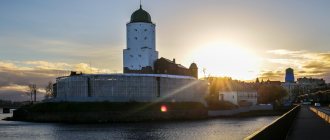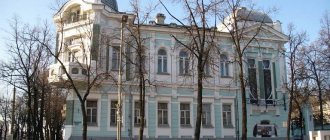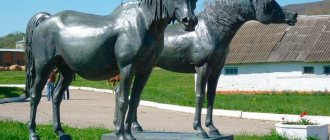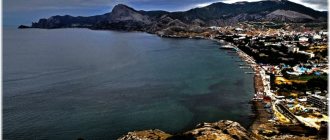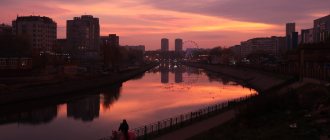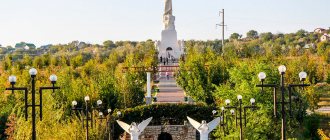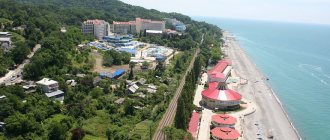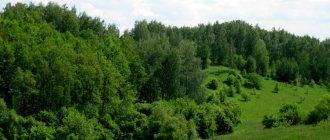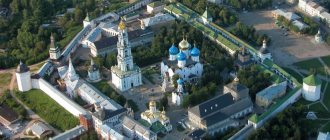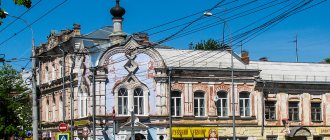Arkhangelsk is a large northern city, located just 35 km from the White Sea.
Arkhangelsk was founded by decree of Tsar Ivan the Terrible in 1584 in the form of a defensive fortress, which was erected in just one year. Thanks to its favorable location, the city quickly turned into a major trading hub, bringing in up to 60% of state treasury revenues, and from the end of the 17th century into the largest northern port of Russia.
For many travelers, Arkhangelsk leaves two impressions: on the one hand, it is one of the oldest cities in the North with a rich history, on the other, few truly historical buildings have survived and most of the buildings are from the Soviet period.
Natural attractions
The climate of Arkhangelsk is harsh, but there are still plenty of natural attractions here. Most of the interesting objects are located outside the city, and within its boundaries, especially in summer, it is worth exploring the green parks and squares.
Petrovsky Park
Before the revolution, this place was called Lomonosov Meadow, then - Gagarin Garden. The city park was laid out back in 1868, and 150 years later it was landscaped and decorated with fountains.
On the territory there is a walking area with shady alleys, benches and a children's playground, separated from the main Lenin Square by the Drama Theater building. The promenade stretches along the developed bank of the Northern Dvina River. In this area there is one of the oldest fountains in the city, where newlyweds often come to take photos.
Various festivals are regularly held in the park: book, art, creative industries, etc.
Arboretum of Northern (Arctic) Federal University
The object of historical, cultural and natural heritage is a division of the Northern Arctic Federal University. The introduction point has existed since 1934 and is considered one of the oldest in the European North.
Here, on an area of 1.6 hectares, more than 200 species of plants from Central Asia, North America, and Central Europe are presented. Perennial flowers, various shrubs and trees are cultivated. The most common are honeysuckle, lilac, apple tree, and hawthorn. Many of them bloom and attract lovers of colorful photo shoots in the summer.
The arboretum has been improved: it is looked after by university student interns. There are tiled paths for walking.
Group excursions are organized at the Arboretum. They are held every day from 8:00 to 16:15.
Literary Square
Opposite the Literary Museum, on Chumbarova-Luchinsky Avenue, a square of the same name was opened in 2022. The entrance to the reading corner is decorated with bronze sculptures. On the creative site, along the tiled paths, there are benches for guests, urns and flower beds.
At the bookcrossing point there is a telephone booth with a restored payphone from the second half of the 20th century. Anyone can take a book of interest from a special bookcase and put another one in its place.
Talented poets and writers perform on the improvised stage of the art space, and connoisseurs of literature and the Russian language come to listen to their readings. The park hosts thematic competitions, master classes and festivals.
Architecture
There are more than 100 architectural monuments in Arkhangelsk, most of which are located in the city center.
Marine river station
The largest river and sea port in the North of Russia stands at the mouth of the Northern Dvina, which continues on its way to the White Sea. For a long time it was the gateway to the Arctic.
The water area of the structure became the base for historically important icebreakers: Kapitan Kosolapov, Dikson, Kapitan Chadayev. Numerous international and Russian ships pass through the waterways passing near the building.
Now the main river and sea gates of Pomorie are under lock and key. Instead of port management offices, there are trading floors inside. In 2022, it was decided to transform the port into a community center with recreation areas, a cafe with local cuisine, co-working space, an interactive museum and a rooftop promenade.
Severodvinsky Bridge
The technical structure was built for six whole years - from 1958 to 1964. The Severodvinsky Bridge was the first among those crossing the Northern Dvina and is considered the front gate of the city. The length of the roadway was 800 m and the height was 28 m.
The bridge has important transport and industrial significance: it carries a two-way road with railway tracks and pedestrian sidewalks, connecting to the M8 highway.
The five-span bridge connected the center of Arkhangelsk and the left bank of the river. It has an adjustable structure for the passage of large vessels with cargo along the Northern Dvina. Most often this happens from 1 am to 4 am. Navigation occurs all year round. The city embankment begins from here.
Building of design organizations
The building is popularly called a simple “high-rise”. The local skyscraper rises 173 m above sea level. The object has become a kind of symbol of Arkhangelsk.
The house was built of concrete in 1983 in the style of Soviet modernism - without any special decorative elements. It dominates the architectural appearance of the city’s main square, Lenin Square.
Until 1990, design organizations and management for the operation of high-rise buildings were located inside. After the collapse of the Union, service centers, travel agencies, cafes, and radio stations began operating in the premises. In the evening, the lighting on the upper floors is turned on, giving the house a more solid appearance.
Cape Pur-Navolok
In Arkhangelsk there is the most common address “Northern Dvina Embankment 86”, but this place is completely unique - Cape Pur-Navolok. Here the beginning of Arkhangelsk was laid, here, at the behest of Ivan the Terrible, the walls of a powerful fortress were erected. But even earlier, the Archangel Michael Monastery stood on the cape, completely destroyed by the Swedes.
Address: Northern Dvina embankment, 86.
Museums and theaters
Arkhangelsk is considered the cultural and historical capital of Pomerania and the center of northern traditions, and therefore there are more than ten museums in the city. Let's take a look at the most interesting of them.
Art Museum
pl.
Lenina, 2 The institution is part of the museum association “Artistic Culture of the Russian North” and has existed since 1960. The museum's activities are related to the collection, storage and exhibition of works by local artists and painters from other cities in Russia and abroad.
The basis of the collection is made up of canvases presented together with wooden sculpture, icon painting, embroidery, and Kholmogory bone carvings. The museum's collection includes over 30 thousand specimens, the oldest of which were created back in the 14th century.
The institution is not only a repository of classical and contemporary art, but also an art center where musical evenings, creative meetings and festivals are regularly held. Interaction with guests takes place at master classes, lectures, and interactive classes.
The Museum of Fine Arts is open every day except Tuesday.
Drama Theater named after M.V. Lomonosov
Petrovsky Park
The date of birth of the theater is considered to be 1932, when a permanent troupe settled in the current building. After a series of restorations, the stage complex has become one of the most modern in Russia and is now capable of hosting artists of different genres and any level. The auditorium (including balconies) seats about 1,200 people.
The theater's repertoire includes more than 40 performances of different genres: legends, comics, dramas, myths, comedies. Performances are staged on stage for both adults and children based on popular fairy tales and poems. From time to time, the institution hosts open readings of plays and lectures on the history of its creation and development.
Museum of Artistic Development of the Arctic
st. Pomorskaya, 3
The institution is part of the museum association “Artistic Culture of the Russian North”. The branch's collection conveys the spirit of the Arctic. The copies introduce visitors to the world of the Russian North, which is filled with blizzards, northern lights, twinkling stars and other magical components.
The composition is built around a thematic design, which, along with corresponding video installations and paintings, creates the atmosphere of a trip to the Far North. The collection is supplemented by ship models, German literature, and maps with polar expedition routes.
Exhibits are displayed in five halls, which are open to the public from Monday to Sunday from 10.00 to 17.00.
Youth theater
Troitsky Ave., 91
The Arkhangelsk Youth Theater dates back to 1975 and was founded on the initiative of the Soviet director Viktor Panov. Now the troupe performs on the stage of a reconstructed wooden mansion built in the 19th century. Despite having only one floor, the building has an auditorium for 100 guests and a fireplace for creative meetings.
The institution goes beyond the theater repertoire and experiments with genres, successfully combining acting, music and visual art. The theater satisfies the interests of lovers of comedy, drama, romance, and thriller. Directors do a great job of realizing poems and plays by domestic and foreign authors: Shukshin, Pushkin, Shakespeare, Turgenev.
The ticket price ranges from 300 to 1000 rubles.
Northern Maritime Museum
embankment of the Northern Dvina
The State Maritime Historical Museum has been working in the scientific and technological field since 1979. The institution's exhibitions are dedicated to the history of maritime exploration of the Arctic, starting with the first maritime charter of Peter I.
In the exhibition hall, with the help of the sound of the sea, the cry of seagulls, and ship models installed in transparent glass cabinets, an atmosphere of Arctic sailing was created.
The Northern Maritime Museum holds permanent and temporary exhibitions on topics dedicated to the most interesting ships of the Arkhangelsk port, the sailing fleet, and polar explorers.
Where to go in the evening
Winter evenings are long, and even more so in the north. If you have already taken a walk and appreciated the evening illumination of the streets, the cultural places of the city await you. In this regard, the Arkhangelsk Drama Theater and the Pomeranian Philharmonic are among the most famous.
The Arkhangelsk Drama Theater is named after M.V. Lomonosov. It occupies a huge waterfront building built in the early 1930s. and then updated more than once. Today the theater's repertoire includes productions based on the works of classics ("Three Sisters", "Doctor Zhivago", "Hamelet") and even the myths of Ancient Greece. The hall seats more than a thousand spectators.
The Pomeranian Philharmonic is located in the former Lutheran Church of St. Catherine. The idea of this is not new and is found in many cities across the country, but it is still unusual due to the rare architecture. This is partly due to the excellent acoustics of such buildings.
Concert hall of the Pomeranian Philharmonic in the old church Photo: © dualia1
A large number of original productions based on lesser-known subjects are offered by the Youth Theater (the theater of V. P. Panov - after the creator). It has a small cozy hall designed for 70 spectators, and occupies a one-story wooden mansion - a beautiful monument of the mid-19th century, the Sharvin house. If in performances the picture is more impressive than the sound, do not ignore the TaburE Theater , whose actors are talented mimes, clowns and hundreds of possible roles.
In search of performances by local and touring pop performers, music and dance groups, study the program of the Northern Russian Folk Choir and cultural posters , Solombala-Art, Severny, Pomeranian ARTel , as well as Nord Expo - a large modern concert and exhibition venue, opened several years ago.
Drama Theater of Arkhangelsk Photo: © dualia1
Churches and cathedrals
Arkhangelsk is considered to be a city of different religions. And indeed, there are Catholic and Orthodox churches, synagogues and mosques here.
St. Catherine Lutheran Church
st. Karl Marx, 3
Nowadays the Lutheran church does not function, but inside it there is a chamber hall of the Pomeranian State Philharmonic. The room has a large organ for musical performances. But church services here will soon resume.
The building itself has stood on this site since 1768. In the design of the facade, a mixture of two styles is striking: neo-Gothic and Baroque. A massive wooden door leads to the entrance, above which there is a triangular pediment. On the left side of the roof rises a bell tower with a triangular dome and a low spire. Semi-oval windows are visible on the pink façade.
St. Elias Cathedral
st. Ilyinskaya, 10A
The temple was founded as a cemetery in 1809 on the site of a church destroyed by lightning. At the same time, next to it, within the boundaries of the fence, a round two-tier bell tower, decorated with a blue dome and spire, grew up. The belfry is hung with 12 bells.
The temple with all its aisles has an elongated shape and a white facade. The walls are pierced with tall rectangular and arched windows. On the gray roof there are two turrets with small domes. Behind the building there is an abandoned burial place of the Soviet-era elite, including nomenklatura workers.
Several shrines are kept in St. Elias, the most notable among which are the icons of the Archangel Michael and the Mother of God, painted by local artists.
Attractions for children
The main attractions of Arkhangelsk for children are theaters, zoo corners and amusement parks.
Puppet Theatre
The modern building of the puppet theater has stood on Trinity Avenue since 1938. The three-story house was created in the spirit of Stalinist classicism. The decor on the beige facade includes stucco molding located between two windows at different levels. In the center there is a superstructure at the third floor level.
The theater's repertoire consists of productions for people of all ages, including children. More than 40 successful performances are staged here and some of them are aimed at adult audiences.
In addition to performances, the puppet theater hosts creative evenings, seminars, excursions, lectures and master classes.
Santa Claus Village
The project was created in 1989 as the official residence of the Russian Father Frost. The patrimony of the fairy-tale character is located on the banks of the Solombala River. The architectural and park complex is open all year round, but is especially active in winter.
During the tour of the “frosty village”, guests are invited to send a letter to the New Year's gift giver to the address of the grandfather's post office house. And you can attend an official reception with Father Frost himself.
On the territory of the village there is another wooden house in which there is a manufacturing shop. Nearby there is a celebration glade with snow sculptures. During the visit, guests are invited to ride a sleigh, dance around the beautiful Christmas tree and drink hot tea.
Mini-zoo "Madagascar"
The zoo is located on the 3rd and 4th floors of the shopping and entertainment center and looks like a tropical corner. The living collection includes exotic birds, mammals and reptiles. The hall features parrots, small goats, hedgehogs, rabbits, monkeys, turtles, kangaroos and even a crocodile.
Each animal is allowed to have contact and be photographed. You can feed the monkeys bananas and carrots, and hold the parrots in your arms. Individual and group excursions are available around the zoological park.
Amusement park "Poteshny Dvor"
The seasonal park with more than 20 attractions is the main place for family and youth recreation in the city in the summer. Entertainment for adults and children is available on site. The most popular among them was the Ferris wheel, which serves as an excellent viewing platform.
Carousels, trampolines, trains, and swings are available for kids. The cheapest attractions are “Yunga”, “Octopus”, “Flight of Fancy”, “Cups”, “Indian River”. On some of them, children under 1 year old can ride for free when accompanied by an adult.
Church of Martin the Confessor
The temple is named after Martin the Confessor, Pope of Rome. Since the temple was built with donations from merchants who loved grandeur, the exterior and interior decoration of the church was impressive. During the years of the revolution, civil war, and even after, the church gradually lost its beauty. But today, after reconstruction, the temple looks the same as during its “golden age”. The church is very loved by the townspeople; it contains the miraculous “Assumption” icons and the myrrh-streaming image of the Mother of God “Quick to Hear”.
Address: Terekhin street, 75.
What to see in Arkhangelsk in 1 day
The total length of the hiking route in one day is about 3 km. It runs through the historical center of the city.
Pedestrian Avenue Chumbarov-Luchinsky
Only the 1 km stretch from Ioann Kronstadtsky Street to Karl Liebknecht Street is pedestrian. The prospect is positioned as an open-air museum, where the best examples of wooden architecture of old Arkhangelsk of the early 20th century are presented.
The most remarkable building of the pedestrian zone is the Marfin House , in which in pre-revolutionary times the entire elite of the merchant class gathered. After the restoration in 2009, new flower beds, benches, lanterns, and cobblestone pavements appeared on the avenue.
Chumbarovka (the unofficial name of the pedestrian section) is decorated with monuments to the famous storyteller Stepan Pisakhov and his hero Sena Malina, as well as a sculpture of the popular Russian author of aphorisms Kozma Prutkov.
Literary Museum
st.
Volodarsky, 10 The institution was created by volunteers in 1992 as a cultural resource based on a society of reading enthusiasts. The museum promotes the Northern Pomeranian word and preserves the history of the development of local literature. The collection contains manuscripts, documents, works of writers and poets who once lived or worked in the Russian North.
The fund contains more than 50,000 exhibits, most of which are of cultural value for all of Russia. The collection includes autographed books by famous writers, as well as their photographs, works, documents and some personal items. The following are stored here: Arkady Gaidar's smoking pipe, Ioann Sergiev's sofa, Boris Shergin's work notebook and even the family archive of Alexander Pushkin.
Gostiny Dvor
The historical and architectural complex on the Northern Dvina embankment had commercial and defensive significance until the beginning of the 19th century, from the moment of its construction in 1684. One tower with a beige facade and a massive gray dome, a western wall stretched along the river, as well as a one-story exchange building with high arched windows have survived to this day.
Nowadays the restored state halls and former merchant chambers are available for inspection. Since 1981, the complex has housed the Local History Museum . The institution holds permanent and temporary exhibitions dedicated to cities, nature, monasteries and towns of the Russian North, the history of the Admiralty and the development of the city as the cradle of the country's navy.
A visit to the historical and architectural complex “Arkhangelsk Gostiny Dvors” costs 300 rubles. Every third Thursday of the month the ticket is provided free of charge for: minors, conscripts, labor veterans and a number of other preferential categories.
Gostiny Dvor
Arkhangelsk was a thriving trading city; moreover, before the founding of St. Petersburg, almost all trade passed through it. The main “shopping point” was Gostiny Dvor. Originally made of wood, it was later rebuilt in stone. Further, the fate of the buildings was sad: trade was transferred to St. Petersburg, Gostiny thief was in desolation. Since then, the fair complex has been rebuilt several times, adding salt warehouses and an exchange building. Now the living thief has come under the jurisdiction of the local history museum; a fragment of the wall and the northern tower have been restored.
Address: Northern Dvina embankment, building 86.
Attractions in the vicinity of Arkhangelsk
In the Arkhangelsk region there are a number of protected areas with pristine nature, museums in honor of famous personalities, as well as ancient architectural objects.
Museum "Malye Korely"
village of Malye Karely
The State Museum of Wooden Architecture and Folk Art of the Northern Regions of Russia is located right in the open air. The complex consists of more than 100 churches, civic and public buildings. The territory features merchants' mansions, fences, mills, baths, peasant huts, and wells.
The exhibitions are divided by territory:
- banks of the Vaga, Mezen and Pinega rivers,
- Pomorie,
- Podvinye,
- Kargopol.
The museum stores mainly wooden products: carts, dishes, furniture, tools, etc. The collection also contains books, paintings, metal, ceramic and glass objects that were used by the inhabitants of the Russian North until the beginning of the 20th century.
In the classic Russian “village” various holidays are celebrated: Ivan Kupala, Trinity, Maslenitsa, Christmas.
Russian Arctic National Park
The park has existed since 2009 and consists of separate islands of the Novaya Zemlya and Franz Josef Land archipelago. The reserve is dedicated to preserving the historical, cultural and natural heritage of the Russian Arctic. The specially protected area occupies a huge area.
Large colonies of ivory gulls are found on the archipelagos, and Arctic walrus and polar bears breed. The park is home to a huge population of the polar subspecies of auk and Atlantic fulmar. And this is the only habitat in the world for the bowhead eider.
Novodvinskaya fortress
The attraction is located in the vicinity of Arkhangelsk in the delta of the Northern Dvina River on the island of Linsky Priluk. The fortress appeared in 1701 to protect the Arkhangelsk fairway. Initially, the complex consisted of 4 bastions and a ravelin, surrounded by a water moat. There was a wooden church inside.
All that remains of the former grandeur of the fortress are mostly ruins. Only part of the southern and western walls of the citadel, as well as the main gate, are in relatively good condition. Since 2007, the building has been listed on the balance sheet of the Arkhangelsk Museum of Local Lore.
You can only get inside the fortress in summer. A tourist route has been laid out for excursionists.
Kenozersky National Park
The pearl of the Arkhangelsk region is the Kenozersky National Park. The reserve boasts a unique natural heritage. The appearance of the protected area was formed from more than 600 species of plants, among which there are also rare ones from the Red Book: Traunsteiner's palmate root, lake grass and many others.
Mountain hares, moose, bears, and squirrels have found a home in the national park. The reservoirs of the reserve contain both widespread fish such as bream, and rare ones: whitefish, vendace, ide, ruff.
Historical and Memorial Museum of M. V. Lomonosov
The museum occupies the former estate of the Lomonosov family, located in the Arkhangelsk village of Lomonosovo. The permanent exhibition is presented in 6 halls. The fund's collection is dedicated to the life and work of the great scientist. The main direction of the institution’s activities is the collection, storage and popularization of spiritual, material and historical monuments.
More than 12,000 items of storage are exhibited in the halls of the historical and memorial museum. About half of the exhibits are from the scientific and technical department, the rest are books, bone carvings, paintings.
A pond has been preserved on the territory of the estate, which was expanded and strengthened as part of the reconstruction.
